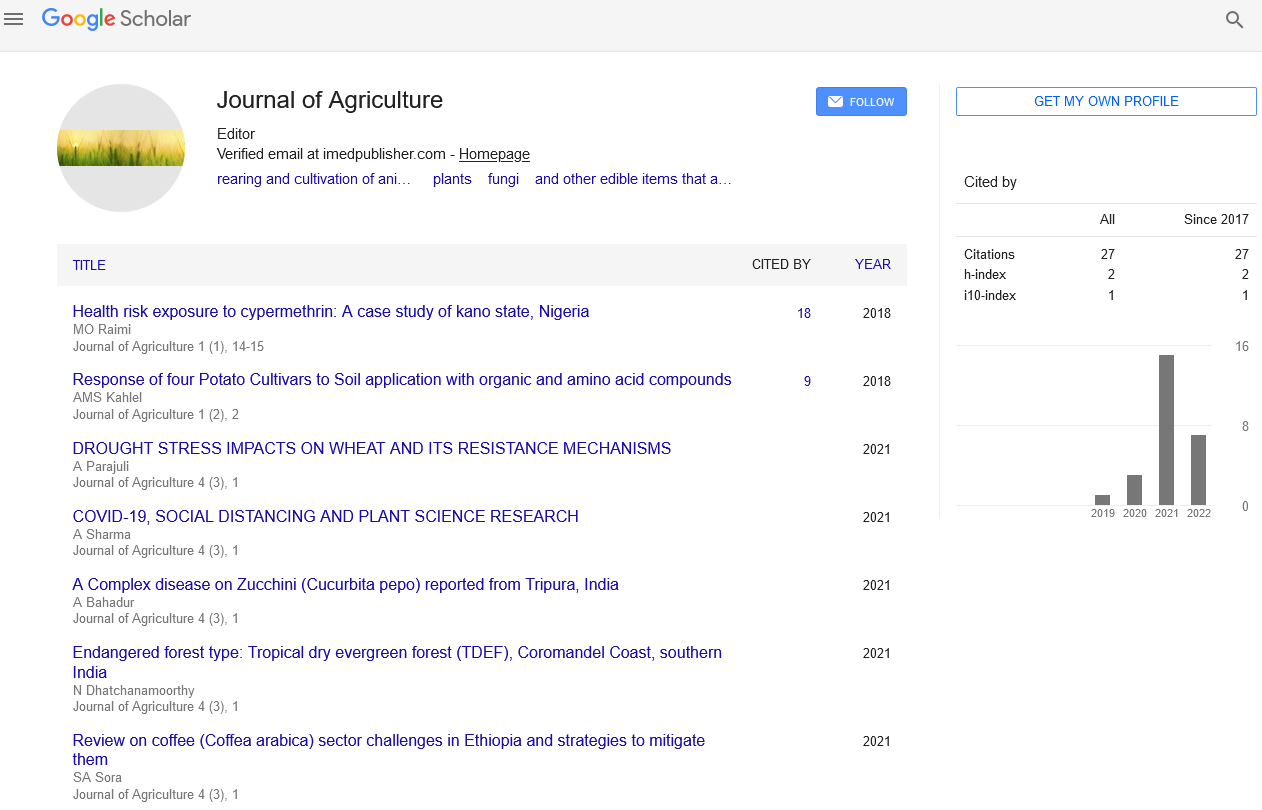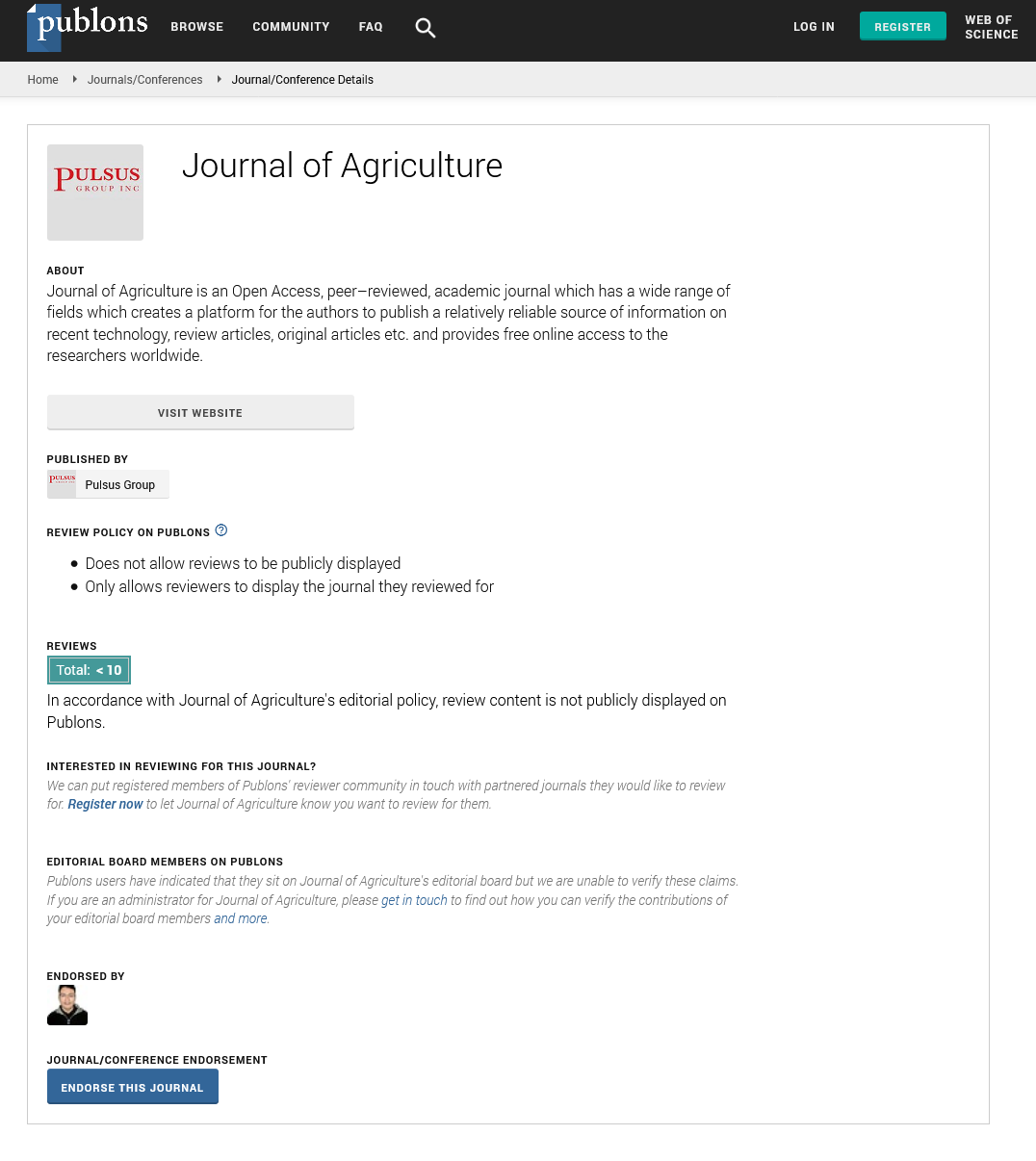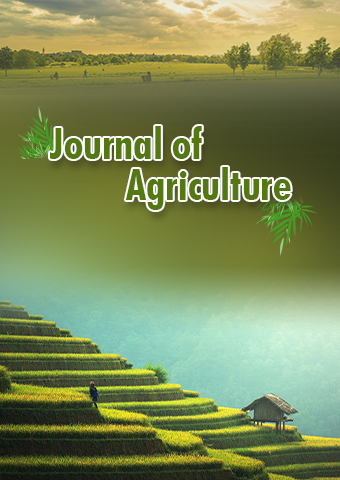Mini Review - Journal of Agriculture (2023) Volume 6, Issue 3
Fostering Equilibrium Between Agriculture and Forests through agroforestry
Ranjan Benia*
Department of Economics, Debre Berhan University, Ethiopia
Department of Economics, Debre Berhan University, Ethiopia
E-mail: Ranjan3567@gmail.com
Received: 31-May-2023, Manuscript No. jagri-23-102486; Editor assigned: 02-Jun-2023, Pre-QC No. jagri-23-102486 (PQ); Reviewed: 16- Jun-2023, QC No. jagri-23-102486; Revised: 21-Jun-2023, Manuscript No. jagri-23-102486 (R); Published: 28-Jun-2023, DOI: 10.37532/ jagri.2023.6(3).67-69
Abstract
Agroforestry is an innovative land management system that integrates trees, crops, and livestock in a sustainable manner. This abstract explores the concept of agroforestry, highlighting its benefits, principles, and potential applications. Agroforestry is an ancient practice that combines agricultural activities with the cultivation and management of trees. It offers a multifunctional approach to land use, promoting ecological, economic, and social benefits. By harnessing the synergistic interactions between trees and other agricultural components, agroforestry systems can enhance productivity, diversify income sources, conserve natural resources, and mitigate climate change impacts. The principles of agroforestry revolve around the strategic arrangement of trees and other components within the landscape. Different types of agroforestry systems exist, including alley cropping, silvopasture, forest farming, and windbreaks, among others. These systems are designed to maximize resource utilization, improve soil health, provide shade and shelter, and foster biodiversity. The selection of tree species is crucial, considering their adaptability to the local environment, desired products, and ecological functions. Agroforestry has a wide range of applications across various geographic regions and climatic zones. In tropical areas, it can play a vital role in addressing deforestation, soil erosion, and biodiversity loss by promoting sustainable land management practices. In arid and semi-arid regions, agroforestry can contribute to water conservation, enhance soil fertility, and provide shade and wind protection. In temperate zones, agroforestry can offer opportunities for diversified farming systems, carbon sequestration, and habitat restoration. The benefits of agroforestry are numerous and far-reaching. It can improve agricultural yields by providing shade, moisture retention, and nutrient cycling. Agroforestry also diversifies income sources for farmers, as trees can produce timber, fruits, nuts, or medicinal products. The presence of trees in agricultural landscapes enhances biodiversity, providing habitat for wildlife and promoting pollination. Furthermore, agroforestry systems sequester carbon dioxide from the atmosphere, mitigating climate change and contributing to climate resilience. Despite the numerous benefits, the adoption of agroforestry faces several challenges. Lack of awareness and knowledge among farmers limited access to appropriate tree germplasm, and inadequate policy support are some of the barriers. Additionally, there may be conflicts between tree and crop/livestock management, and the long-term nature of agroforestry investments requires patience and commitment. Agroforestry offers a sustainable and holistic approach to land management that combines agricultural production with tree cultivation. It provides a range of benefits, including improved productivity, environmental conservation, and climate change mitigation. Although challenges exist, the promotion and adoption of agroforestry systems can contribute to a more resilient and sustainable agricultural future.
Keywords
Agroforestry • Economic • Synergistic • Silvopasture
Introduction
Agroforestry is an innovative land management system that integrates trees, crops, and livestock in a mutually beneficial manner. It offers a sustainable and holistic approach to agriculture, combining the productivity of agriculture with the environmental benefits of forestry. By combining trees and shrubs with agricultural crops, agroforestry systems maximize land use efficiency, conserve natural resources, enhance biodiversity, and provide economic opportunities for farmers [1]. This article explores the concept of agroforestry and highlights its numerous benefits for both farmers and the environment.
Understanding agroforestry
Agroforestry is a centuries-old practice that involves the deliberate integration of trees, crops, and/or livestock on the same land. It differs from traditional agriculture in its emphasis on the simultaneous cultivation of both woody and non-woody plants, providing a diverse array of products and services. Agroforestry systems can take various forms, such as alley cropping, silvopasture, forest farming, and windbreaks, each designed to meet specific ecological and socioeconomic goals [2].
Environmental benefits of agroforestry
Soil conservation: Trees and shrubs in agroforestry systems help prevent soil erosion by reducing wind and water velocity, acting as natural barriers. Their roots stabilize the soil, preventing nutrient runoff and preserving its fertility [3].
Biodiversity conservation: Agroforestry systems promote biodiversity by creating habitat for diverse plant and animal species. The combination of trees, crops, and livestock provides a range of niches, fostering a more balanced and resilient ecosystem.
Carbon sequestration: Trees are excellent carbon sinks. Agroforestry enhances carbon sequestration by increasing the overall tree cover on agricultural lands. This aids in mitigating climate change by reducing greenhouse gas emissions [4].
Water Management: Trees play a crucial role in regulating the water cycle. Agroforestry systems improve water quality by filtering runoff, and their root systems enhance groundwater recharge, reducing the risk of droughts and floods.
Economic benefits of agroforestry
Diversified income streams: Agroforestry offers farmers multiple revenue streams by combining the production of timber, fruits, nuts, medicinal plants, fodder, and other crops. This diversification reduces reliance on a single product and provides a stable income throughout the year [5].
Increased resilience: Agroforestry systems are more resilient to climatic variations, pests, and diseases. By spreading risks across different crops and trees, farmers can better withstand market fluctuations and environmental challenges [6].
Improved soil fertility: The integration of trees in agroforestry systems enhances soil fertility by fixing nitrogen, cycling nutrients, and improving organic matter content. This reduces the need for external inputs like chemical fertilizers, resulting in cost savings for farmers.
Promoting agroforestry adoption
Knowledge and Training: Governments, NGOs, and agricultural institutions play a vital role in providing education and training on agroforestry practices. Accessible knowledge resources, workshops, and field demonstrations can help farmers understand the benefits and implementation techniques [7].
Policy support: Governments can incentivize agroforestry adoption through supportive policies, such as tax breaks, subsidies, and land tenure security. Policy frameworks should be developed to integrate agroforestry into national agricultural strategies and land-use planning [8, 9].
Market development: Creating markets and value chains for agroforestry products is essential to ensure farmers have viable economic opportunities. Collaborations with industries, local markets, and consumers can help promote and market agroforestry products effectively [10].
Conclusion
Agroforestry is a land-use management system that combines the cultivation of trees or shrubs with agricultural crops or livestock. It is a sustainable approach that aims to maximize the productivity and environmental benefits of both agriculture and forestry. The results of implementing agroforestry practices can vary depending on various factors such as the specific techniques used, the geographical location, soil conditions, climate, and the goals of the farmer or landowner. However, agroforestry has been shown to provide numerous benefits: It’s important to note that the specific outcomes of agroforestry practices can vary depending on the context. Factors such as farm size, local markets, and farmers’ knowledge and skills can influence the success and effectiveness of agroforestry systems. Local expertise, research, and tailored approaches are crucial for optimizing the benefits and overcoming challenges in implementing agroforestry at a specific location.
References
- Zhao J, Li M, Gu D et al. Involvement of rice histone deacetylase HDA705 in seed germination and in response to ABA and abiotic stresses.Biochemical and Biophysical Research Communications.470, 439-444(2016).
- Liu X, Luo M, ZhangW et al. Histone acetyltransferases in rice (Oryza sativaL.): phylogenetic analysis, subcellular localization and expression.BMC plant biology.12,1-17 (2012).
- Menz J, Modrzejewski D, Hartung Fet al. Genome edited crops touch the market: a view on the global development and regulatory environment. Front Plant Sci. 11,586027 (2020).
- riksson D, Custers R, Edvardsson Bjornberg K, et al. Options to reform the European Union legislation on GMOs: postauthorization and beyond. Trends Biotechnol.38, 465–7(2020).
- Schwartz SE, Levine RA, Weinstock RS et al. Sustained pectin ingestion: effect on gastric emptying and glucose tolerance in non-insulin-dependent diabetic patients. Am J Clin Nutr. 48, 1413-7 (1988).
- Booth FW, Chakravarthy MV. Physical activity and dietary intervention for chronic diseases: a quick fix after all. J Appl Physiol. 100, 1439-40 (2006).
- Anderson JW, Ward K. High-carbohydrate, high-fiber diets for insulin-treated men with diabetes mellitus. Am J Clin Nutr. 32, 2312-21 (1979).
- Anderson JW, Ward K. High-carbohydrate, high-fiber diets for insulin-treated men with diabetes mellitus. Am J Clin Nutr. 32, 2312-21 (1979).
- Lahat G, Lazar A, Lev D et al. Sarcoma epidemiology and etiology: potential environmental and genetic factors. Surg Clin North Am. 88, 451-481 9 (2008).
- Hoar SK, Blair A, Holmes FF et al. Agricultural herbicide use and risk of lymphoma and soft-tissue sarcoma. JAMA. 256, 1141-1147 (1986).
Indexed at, Google Scholar, Crossref
Indexed at, Google Scholar, Crossref
Indexed at, Google Scholar, Crossref
Indexed at, Google Scholar, Crossref
Indexed at, Google Scholar, Crossref
Indexed at, Google Scholar, Crossref
Indexed at, Google Scholar, Crossref
Indexed at, Google Scholar, Crossref
Indexed at, Crossref, Google Scholar


